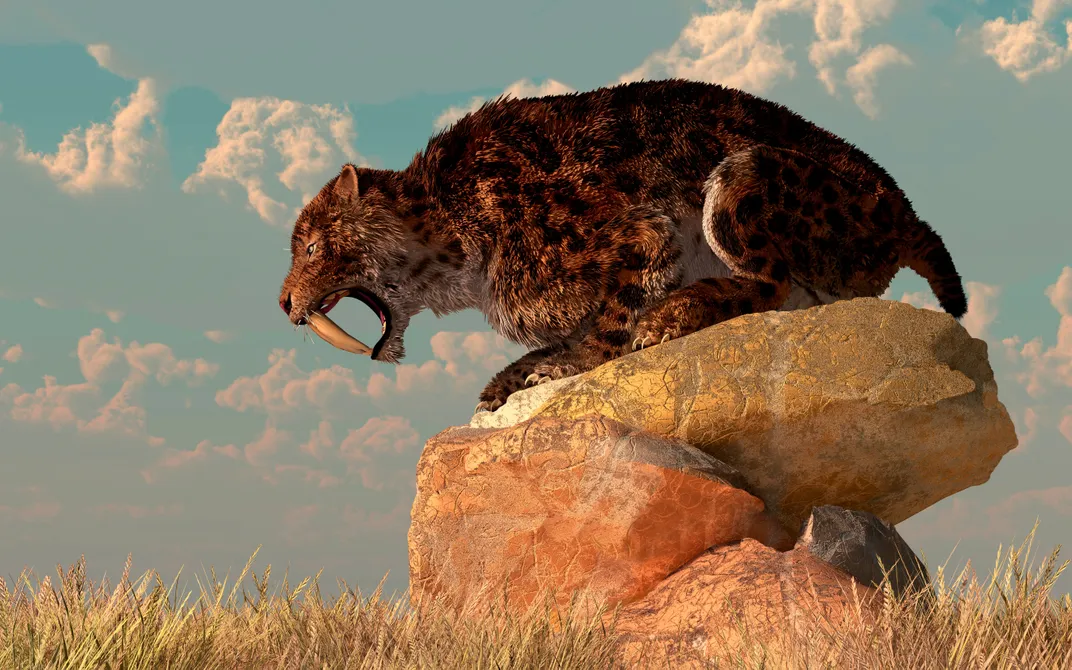How Did Sabercats Use Those Outlandish Fangs?
We’ve barely scratched the surface of how this charismatic cat utilized its dental cutlery
/https://tf-cmsv2-smithsonianmag-media.s3.amazonaws.com/filer/1b/6e/1b6eb11f-b1fb-4170-b6a7-6289bf3fe211/istock-183367980.jpg)
Of all the vicious smiles to have ever evolved, it’s hard to beat the grin of the aptly named Smilodon. The largest of these Ice Age cats sported canines that were 11 inches long, with fine serrations giving the fangs even more of a cutting edge. Yet despite the fact that this felid has been famous for its dental cutlery ever since the early 19th century, paleontologists are still trying to figure out just how it used its impressive teeth. How do you bite when you have an excess of tooth?
There’s no shortage of ideas about what Smilodon did with its ludicrously long fangs. The 19th century paleontologists Richard Owen and Edward Drinker Cope, for example, both suggested that Smilodon was a living can-opener, those teeth being an adaptation to cut through the tough and often armored hides of giant sloths and huge armadillos. Other experts, such as paleontologist George Gaylord Simpson, proposed that Smilodon used them to slash or stab. It was even suggested that the palate of the great sabercat suggested a propensity for sucking, painting Smilodon as a sort of Ice Age vampire.
Sadly, there are no living Smilodon to study—the last of these cats died out about 8,000 years ago—and the humans who undoubtedly saw them did not think to carefully document their feeding habits. On top of that, today’s big cats aren’t very helpful as analogs. Lions, for example, have shorter, conical teeth and use “throttling bites” to clamp around the throats of large prey, clamping down the windpipe. This option wasn’t open to Smilodon. But thanks to reinvestigations of old bones and high-tech analysis, paleontologists are finally starting to get a handle on how Smilodon employed those terrible teeth.

Part of the answer is to stop thinking just about teeth and jaws. With an anatomist’s eye, various aspects of the Smilodon skull jump into focus as different from those of their living feline cousins. “The back and base of sabercat skulls tend to show very expanded and bulky bony areas for the attachment of large neck muscles,” says Zhijie Jack Tseng, a paleontologist at the State University of New York at Buffalo, “leading some researchers to suggest that prey killing involved significant contribution of neck power.”
A 2007 study by Colin McHenry and colleagues, for example, found that Smilodon had a bite only about a third as powerful as a lion’s, yet the fossil feline had bulky neck muscles that would have aided a quick killing stroke.
Having saberteeth wouldn’t be of much benefit without a jaw able to open extraordinarily wide. That's why many sabercats also have modified lower jaw joints that allowed the jaws to swing open to clear those fangs, Tseng says. And looking beyond the skull and neck, Smilodon also had exceptionally muscular arms. Taken together, says Des Moines University paleontologist Julie Meachen, it's likely that “Smilodon used its very muscular neck and forearms to assist in the kill bite.”
Keeping prey pinned down was critical to the process. Compared to today’s lions and tigers, Tseng says, “the thin sabers suggest that, whatever the killing behavior, it was more important for Smilodon to keep the prey immobilized long enough to use the sabers so they don’t bend sideways in the direction of weakness.” This risk isn’t just theoretical: Rare specimens of Smilodon from the La Brea asphalt and other sites bear broken fangs.
Envisioning how Smilodon killed the horses and camels of its time, then, is not just about the bite. Smilodon didn't have the proportions of a fast-running cat, Meachen says, meaning that the beast “probably would stalk its prey from a hidden position, then leap out at prey and knock it off balance using its weight.” The arms came into play at this moment, grappling and pinning the victim as the cat got ready to inflict the fatal blow.
Here, however, we hit a freeze frame; there's still some uncertainty about how Smilodon would have best employed its teeth. “Either Smilodon would rip out the prey’s throat,” Meachen says, “or it would make a precise killing bite, severing the carotid artery and then it would remove its teeth and start eating.” Either way, it would have been a huge mess.
Naturally, Smilodon wasn’t the only sabertooth around. The cat was among the last, the largest and—thanks to the thousands of bones pulled from the asphalt of La Brea—best-known, but sabertoothed carnives have evolved over and over again throughout the history of life. Looking at the filiform side of the carnivoran family tree alone, sabertooths evolved at least three times: both the true sabercats and two lineages of “false” sabercats called nimravids and barbourofelids. This raises the question of whether sabercats may one day make a comeback.
Some point to the clouded leopard of Asia has sometimes as having the potential to become the next sabertooth. The cat’s canines are long for its size; perhaps, over time and with the right evolutionary nudging, the clouded leopard or another cat could take Smilodon's place. Whether that ever happens, though, depends on the fate of today’s felids: Clouded leopards are currently listed as “vulnerable” on the IUCN’s Red List of Threatened Species.
“I think it’s possible, hypothetically in an ideal world,” that a new sabercat could evolve, Meachen says. “But I think in the real word, most carnivores will become extinct due to habitat loss, hunting and climate change.” If we’re ever going to see sabercats return, we’ll have to safeguard the imperiled cats around us today.
/https://tf-cmsv2-smithsonianmag-media.s3.amazonaws.com/accounts/headshot/RileyBlack.png)
/https://tf-cmsv2-smithsonianmag-media.s3.amazonaws.com/accounts/headshot/RileyBlack.png)